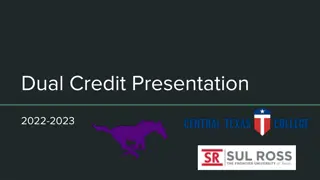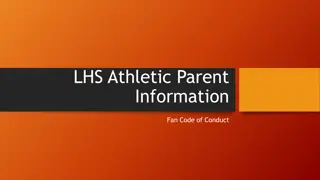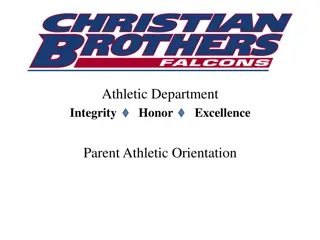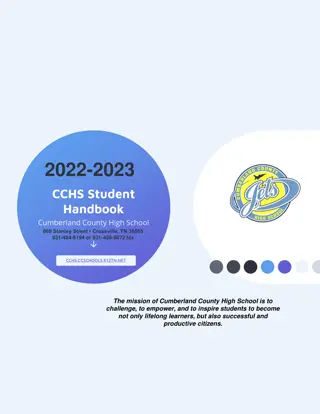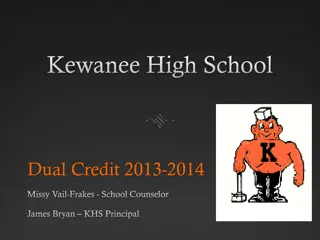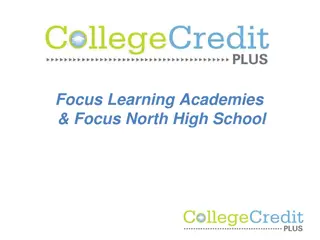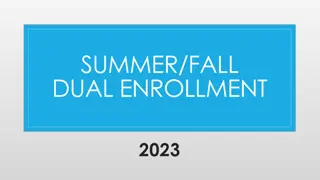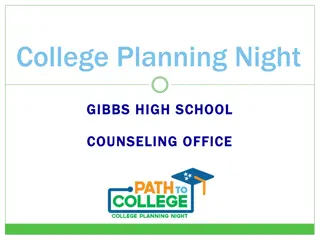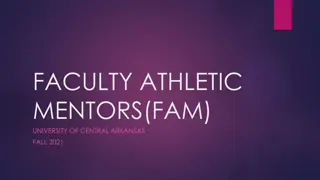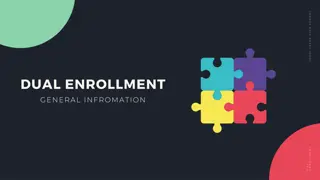Navigating College Athletic Ambitions: A Comprehensive Guide for High School Students
Explore a detailed roadmap for high school student-athletes aiming for college sports participation. From setting long-term goals to understanding NCAA core courses, this guide provides essential advice, timelines across all high school years, and insights into the NCAA application process. Start early, stay focused, and pursue your athletic and academic aspirations with confidence!
Download Presentation

Please find below an Image/Link to download the presentation.
The content on the website is provided AS IS for your information and personal use only. It may not be sold, licensed, or shared on other websites without obtaining consent from the author. Download presentation by click this link. If you encounter any issues during the download, it is possible that the publisher has removed the file from their server.
E N D
Presentation Transcript
GUIDING THE COLLEGE-BOUND STUDENT ATHLETE NHS School Counseling Department
PLAN IT OUT: ONE STEP AT A TIME! SHORT TERM & LONG TERM GOALS Long Term Goal! Short Term Goal Short Term Goal Short Term Goal Short Term Goal Short Term Goal
HIGH SCHOOL TIMELINEFOR STUDENT ATHLETES: THINK BIG PICTURE Extends across all four years of high school Short term goals each year! Understand how it all fits together to meet the long term goal Start early, start early, start early! Small steps and consistent effort lead to the end goal
FRESHMANYEAR The sooner you know you want to play sports in college, the better. Create a four year academic plan to ensure you are taking the correct classes in the NCAA core curriculum so that you are eligible later on Strive for high academic achievement Go to sports camps, play in leagues & tournaments, and get as much exposure to the sport as possible Weight train, condition, and play in the off- season
NCAA CORE COURSES Core courses are classes that are required by the NCAA to determine eligibility Comes into play with course selection and academic planning! The NCAA offers a very nice rule of thumb for how to academically prepare as a student athlete, regardless of whether you eventually play for an NCAA school or not. For more information, go to their website at: http://www.ncaa.org/student-athletes/future/core-courses To learn what core courses are offered at NHS, go to this link and enter our high school CEEB Code 391015, and search. https://web3.ncaa.org/hsportal/exec/hsAction?hsActionSubmit=searchHighSchool
JUSTINCASEYOUREWONDERINGWHAT THE NCAA IS National Collegiate Athletic Association Helps to make competition fair, safe, and sportsmanlike Oversees 23 sports and championships Enforces NCAA rules Gives advice, support, and money to member institutions Apply to the NCAA Eligibility Center if you intend on playing at a Division I or II school Assess your academic standing www.eligibilitycenter.org
THEREISALSOTHE NAIA & NJCAA National Association of Intercollegiate Athletics Another governing body of athletics programs Comparable to the NCAA Division II schools in terms of size of the school and also the level of play Commonly, small private institutions Apply to the NAIA Eligibility Center at www.playnaia.org if you are considering attending one of its member institutions National Junior College Athletic Association Athletic governing body for athletics at two-year colleges Students can attend a two-year college, play sports, and then transfer to a four-year university. Discuss your athletic eligibility with the athletic personnel at the NJCAA college where you want to attend
FRESHMENYEAR(CONTINUED) Start your athletic resume and continually edit it over the years Familiarize yourself with Penn Live s website on High School Sports in our area They are creating a digital footprint on your stats http://highschoolsports.pennlive.com/
FYI: WHATDOADMISSIONSCOUNSELORS CONSIDERWHENREVIEWINGAPPS? Percentage of Colleges Attributing Different Levels of Importance to Factors in the Admission Decision* Considerable Importance Moderate Importance Limited Importance No Factor Importance 82.3% 11.6% 4.4% 1.7% Grades in college prep courses 65 25.2 6.6 3.1 Strength of curriculum 56.1 31.3 9.2 3.4 Admission test scores (ACT, SAT) 49.8 37.5 11.6 1.0 Grades in all courses 19.7 38.1 25.2 17.0 Essay or writing sample My point? Academics are a HUGE part of college admission, and it really starts to count in 9th grade! *Clinedinst, M., Hurley, S., & Hawkins, D. (2013). State of College Admissions, 2013. Washington, DC: National Association for College Admission Counseling.
ACADEMIC ACHIEVEMENT Regardless of how talented your athletic abilities are, your grades will make the biggest difference in admissions and financial aid outcomes! Every college has academic scholarships or grant money that is awarded to students who demonstrate academic achievement. High academic achievement means you will be accepted into more colleges, have greater college choices, and increase the likelihood of receiving money for college. It will help to set you apart from other student athletes!
SOPHOMORE YEAR Focus on strong grades & continue to make sure you are taking classes that are NCAA approved. Take the PSATs in the fall (October) Continue to participate in leagues, programs, camps, tournaments, showcases, etc. (Even in the off-season) Scouts will likely be at these events! Honestly assess your ability level to determine at what level of play you will pursue at college (DI, II, or III); Ask others to help you! Start to research colleges, including their academic and athletic programs
HOWDOYOUASSESSYOURABILITY? Ask trusted coaches, adults, and mentors Go watch teams of various levels compete Be honest with yourself Research how you measure up to others who have been recruited before you (i.e., height, sports stats, etc.) Recommended resources that detail how to evaluate your talent: Men s All-Sports Reference Guide Women s All-Sports Reference Guide https://dynamitesports.com/product-category/all-sport- reference-guides/
SOPHOMORE YEAR(CONTINUED) Talk to your coach about what showcases or college venues could help you to gain exposure Meet with your school counselor and use the NCAA Eligibility Calculator to determine your GPA in the NCAA core courses http://www.ncaacalculator.com/
SOPHOMORETHRU JUNIORYEAR: COLLEGE SEARCH You will be looking at A.) Colleges that are interested in you to play for them, and B.) Colleges that you are interested in attending that may not be actively recruiting you. So what does the college process look like?! Where do I start?!
THE COLLEGE PROCESS OVERVIEW Determine college search criteria What do you want? Broad college search Explore what s out there Narrow college search Find 4-6 that are a good fit! Do college visits Visit those 4-6 schools Take the ACT and/or SAT Spring of junior year/Early fall of senior year Thoughtfully do course selection each year Job shadow when possible July - ??? Apply to college Request letters of recommendation and transcripts Write college essays October - FAFSA filing starts (FAFSA deadlines vary by school) 10. Anytime! Scholarship time! (Local scholarships really start to become available in December of senior year). 1. 2. 3. 4. 5. 6. 7. 8. 9.
STUDENT ATHLETES & COLLEGE: HOWISYOURCOLLEGEPROCESSDIFFERENT? Required to do more than someone who is only applying to college because you are also involved in the recruiting process Preparation looks different (i.e., sports camps, etc.) Timelines are moved up Market yourself to coaches Showcase yourself on two platforms: Athletics and academics Considerations for how athletics will fit into your life at college (major transition)
CONSIDERATIONSFOR STUDENT ATHLETESATTHE COLLEGE LEVEL Physical demand In-season and off-season Mental Challenge Extensive travel Extensive practice and game schedules Time management becomes paramount Academic eligibility It s a different experience for a college student who plays sports.
STARTTHINKINGABOUTWHATYOUWANT INACOLLEGE, SOLET SPRACTICE! ANSWER ME THIS I would like to have a prominent place in organizations, Individual attention from teachers is important to me. I learn best if I can speak out in class and ask questions. I am undecided about what I want to in the city, within commuting distance, etc. Think about get an excellent education. Yes? I want to go to a school nearby, far away, near the ocean, Are you looking for special programming I want to go to a good college where I can I enjoy participating in activities. Yes or No? on campus, in my dorm, in classes, etc. Yes or No? Yes or No? Yes or No? study. Yes or No? WHERE you d want to go to school. such as sports, art, drama, etc.?
DETERMINE SEARCH CRITERIA: FINDINGTHERIGHTFIT Housing Campus life Food Majors Programs Facilities Study abroad Perks? Athletic Fit
FITISSOIMPORTANT! Find schools that you WANT to attend because they meet your needs and wants Use college search tools such as Naviance SuperMatch (Use your student account) and Big Futures College Search (Free through the College Board) Get on campus and do college visits! Make a list of pros & cons of different schools Use a College Comparison Worksheet like the one found here: https://www.act.org/content/dam/act/unsecured/documents/CollegeComparisonWorksheet.pdf What if you had a career-ending injury? Would you still want to go to that school?
ATHLETIC FIT Identify the division level you can play at so that you target the right schools where you have the best chance of securing a coveted slot on the team Be honest about your athletic ability Ask your coaches and others that you know will be honest and candid with you Go see teams at various levels compete. Are there any schools that are showing interest? What division do they belong to? This is often a good indicator. Watch the schools you are interested in playing for compete in your sport. Watch how the coaches coach and how the players react to them. You do not want to waste your time focusing on colleges with the wrong athletic division and academic requirements.
WHATSTHEDIFFERENCEBETWEENTHE DIFFERENTDIVISIONS? Offers at least 7 sports for men and 7 for women OR 6 for men and 8 for women Offers 2 team sports for each gender Have both male and female teams or participants for each sport s playing season Offer a certain number of financial aid awards to student-athletes, without going over the maximum amount allowed Play a certain number of contests against Division I opponents (Meet attendance requirements, which is specific to basketball and football) Offers at least 5 sports for men and 5 for women OR 4 for men and 6 for women Offers 2 team sports for each gender Have both male and female teams or participants for each sport s playing season Have at least the minimum number of contests and participants for each sport Offers at least 5 sports for men and 5 for women Offers 2 team sports for each gender Have both male and female teams or participants for each sport s playing season Have student-athletes who do not get sports-related financial aid Division I Division II Division III
WHATARECOLLEGECOACHESLOOKING FORWHENTHEYARERECRUITING? Think of it as a sandwich Top of the sandwich: Athletic Ability Sportsmanship Desire to Improve Willingness to Learn Commitment Leadership Consistency Work Ethic All the things in the middle of the sandwich will keep the student a recruiting possibility and eventually, keep them on the team! Bottom of the sandwich: Potential
HOWDOESRECRUITINGAFFECTYOUR COLLEGESEARCH? Colleges may enter your radar that weren t on your original list because scouts saw you at showcases or camps. Have your Fit List and must-haves ready to see if the college may become a contender. Do your research! Academics Athletics Fit, fit, fit, fit!
MAKE 3 LISTS List 1 Colleges that are actively recruiting you or have shown an interest If you are on a school s recruiting list: The coach calls or emails you directly The coach sends you a personal card or letter The coach has contacted your high school coach and talked about interest List 2 Colleges that you are interested in attending but you are not being actively recruited by them (yet) List 3 Colleges that you are interested in attending AND you are being recruited by them
JUNIORYEAR(CONTINUED) Continue to take NCAA core courses and strive for the high academic performance Continue to update your athletic resume Continue to participate in leagues, programs, camps, tournaments, showcases, etc. Register with the NCAA Eligibility Center or the NAIA Eligibility Center, if you haven t done so already. Before school starts for your junior year, send a letter of interest, your athletic resume, and your athletic sports schedule(s) to the coach(es).
JUNIORYEAR(CONTINUED) Register to take the SATs/ACTs Compile a list of prospective schools Complete Athletic Questionnaires on the college websites for your sport Compile a highlight video; Ask your coach for help! Communicate with the coach(es) if you are doing anything noteworthy throughout the year that may interest them, so that they can note your exceptionality or attend an event you will be at. Make unofficial college visits and let coaches know well in advance when you will be there (Take an unofficial copy of your transcript with you) Ask for letters of reference from teachers, coaches, and your school counselor
THE IMPORTANCEOFCOMMUNICATION Most schools recruiting budgets are small, and coaches rely on you to contact them. College coaches are very busy, they don t have the time or budget to travel around the country to see you compete. Phone calls, emails, letters, athletic resumes, stats, videos and references become key tools for the coach in the recruiting and evaluating process. You might think that it s too self-promoting to make the initial contact with a coach and to market yourself repeatedly. However, this is the norm. If you don t do it, other student athletes will get the opportunity, get noticed, and get recruited because they will have made the effort and received the attention. These days, college coaches expect you to do this, it s an expected practice!
JUNIORYEAR(CONTINUED) At the end of the school year, send an updated athletic resume to the coaches of interest. Look to attend summer camps, showcases, etc. over the summer months. Be sure your SAT/ACT scores are sent to the NCAA Eligibility Center (Code: 9999)
SENIOR YEAR Retake SATs/ACTs immediately in the fall, if needed Be sure your registration with the NCAA/NAIA is finalized Narrow your choices and apply to college; Can start as early as July 1 Set up official/unofficial visits with colleges and college coaches (Plan to spend the night with the team) After October 1st, file the FAFSA with your parents (fafsa.ed.gov) Continue to be in touch with college coaches by sending them updates that highlight you!
APPLYINGTO COLLEGE Apply to the schools you identified to be a good fit Apply to 4 or more schools Apply to at least one SAFE school Apply to at least one REACH school Apply to at least two MATCH schools Request your transcript using your Naviance account Log-in > Colleges Tab > Transcripts (Left hand side of the screen) Send your SAT/ACT scores from the testing agency
APPLYINGTO COLLEGE: WHERETO APPLY The decision on where to apply should be based off of all of the information you have collected through college visits, research, admission requirements, comfort level, and best fit according to size, location, academics, finances, etc., and we can group these potential schools into three buckets: 2 3 1 Dream/Reach School The Match School Safe School Almost a guarantee for admission Student is above the stated minimum/avg. admission requirements Still needs to be a school that the student can envision him/herself attending A good fit academically & in his/her heart Falls in the middle of the admission requirements Comfortable size, location, campus life, & offers appropriate student services Student falls below one or more areas required for admission Opportunity to be considered Represents an aspiration The College Board recommends that students apply to four or more schools because: 1. It can save you money because every college has different scholarships and financial aid packages. 2. It increases your odds of getting into college. 3. It increases your chances of finding a good academic, social, and financial fit, which will positively influence your overall college experience! * Information adapted from https://student.collegeboard.org/apply-to-4
UNDERSTANDINGTHERECRUITING COLOR WHEEL Red Shirt Gray Shirt Green Shirt Blue Shirt http://www.usatoday.com/story/sports/ncaaf/recru iting/2016/01/31/college-football-recruiting- redshirt-greenshirt-grayshirt- blueshirt/79603750/
RECRUITING TERMS Verbal commitment When a college-bound student athlete verbally agrees to play sports for a college before he/she signs or is eligible to sign a National Letter of Intent. The commitment is not binding Official commitment Student signs a National Letter of Intent, agreeing to attend that school for one academic year Binding www.ncaa.org/student-athletes/future/recruiting
SENIOR YEAR(CONTINUED) File the PA State Grant Form (Financial aid) File any necessary financial aid forms with the college After April 1st, request your final amateurism certificate from the NCAA Be sure your final transcripts are uploaded to NCAA/NAIA and are sent to your college Make a final decision on where you will be attending! Sign your letter of intent! Celebrate! (And breathe a sigh of relief)
RESOURCES NCAA Guide to the College-Bound Student-Athlete (Found online at NCAA.org) NCAA Eligibility Calculator (Found online at ncaacalculator.com) NAIA Guide to the College-Bound Student-Athlete (Found online at NAIA.org) NJCAA Eligibility Rules (Found online at NJCAA.org) To learn what NCAA core courses are offered at NHS, go to this link and enter our high school CEEB Code 391015, and search. https://web3.ncaa.org/hsportal/exec/hsAction?hsActionSubmit=searchHighSchool Familiarize yourself with Penn Live s website on High School Sports in our area They are creating a digital footprint on yourstats each sports season http://highschoolsports.pennlive.com/ College Recruiting Tips Video (Approximate length: 1 hour) https://youtu.be/NvR5thfRmy4 Recommended resources that detail how to evaluate your talent: Men s All-Sports Reference Guide Women s All-Sports Reference Guide https://dynamitesports.com/product-category/all-sport-reference-guides/ Understanding the Recruiting Color Wheel http://www.usatoday.com/story/sports/ncaaf/recruiting/2016/01/31/college-football-recruiting- redshirt-greenshirt-grayshirt-blueshirt/79603750/ College Comparison Worksheet https://www.act.org/content/dam/act/unsecured/documents/CollegeComparisonWCollegeC.pdf Naviance College SuperMatch Transcript Requests Requests for Letters of Recommendation
REFERENCES www.ncaa.org www.naia.org www.njcaa.org www.woosterschool.org www.siprep.org Information adapted from https://student.collegeboard.org/apply-to-4 Clinedinst, M., Hurley, S., & Hawkins, D. (2013). State of College Admissions, 2013. Washington, DC: National Association for College Admission Counseling.






